
Dampiera stricta commonly known as blue dampiera, is a flowering plant in the family Goodeniaceae. It is a small sub-shrub with variable leaves and mostly blue, mauve or purple flowers.

Scaevola hookeri, commonly known as the creeping fan-flower or alpine fan-flower, is a species of flowering plant in the family Goodeniaceae. It has white or blue flowers with a yellow throat and grows in eastern Australia.

Podolobium ilicifolium, commonly known as prickly shaggy-pea, is a flowering plant in the family Fabaceae and grows in eastern and southern Australia. The inflorescence is a cluster of yellow or orange pea-like flowers with red markings and shiny green, prickly foliage.
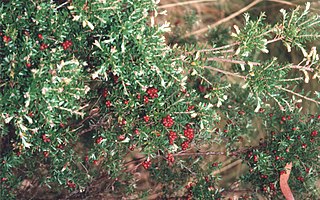
Acrothamnus hookeri, commonly known as the mountain beardheath, is a flowering plant in the family Ericaceae and grows in subalpine regions of southeastern Australia. It is a small upright shrub with oblong-shaped leaves and white flowers.
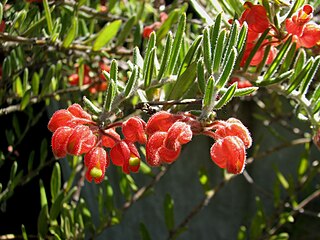
Grevillea saccata, commonly known as pouched grevillea, is a species of flowering plant in the family Proteaceae and is endemic to the south-west of Western Australia. It is a low, spreading to diffuse, scrambling or trailing shrub with linear to oblong or egg-shaped leaves with the narrower end towards the base, and small clusters of red and orange flowers with a lime-green style.
Eucalyptus histophylla is a species of mallee or small tree that is endemic to southern Western Australia. It has smooth bark, often with ribbons of shed bark, linear to narrow lance-shaped adult leaves, flower buds arranged in groups in leaf axils, white flowers and cylindrical to barrel-shaped or conical fruit.

Hakea tuberculata is a flowering plant in the family Proteaceae and is endemic to several isolated areas along the coast in the Peel, South West, Great Southern and Goldfields-Esperance regions of Western Australia. It is an upright shrub with white flowers and rigid, prickly leaves.
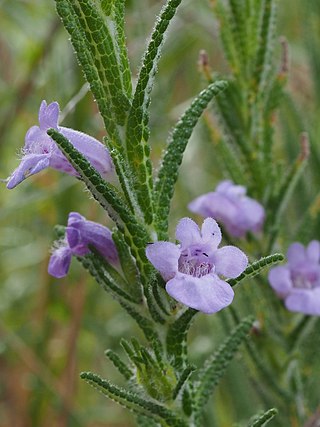
Chloanthes parviflora is a species of flowering plant in the family Lamiaceae. It is a small, rounded shrub with dark green, linear leaves and mauve tubular flowers. It grows in New South Wales and Queensland.

Dampiera rosmarinifolia, commonly known as rosemary dampiera, is a flowering plant in the family Goodeniaceae.It is a perennial subshrub with linear leaves, mauve or purple flowers borne in leaf axils.

Stachystemon polyandrus is a species of flowering plant in the family Picrodendraceae and is endemic to the southwest of Western Australia. It is a diffuse to straggling, monoecious shrub with crowded, oblong, elliptic or egg-shaped leaves with the narrower end towards the base, and small yellowish-white flowers arranged singly in upper leaf axils, but forming clusters at the ends of branches.

Dampiera incana, commonly known as the hoary dampiera, is a flowering plant in the family Goodeniaceae and is endemic to Western Australia. It is a perennial herb with grey foliage and blue-purple flowers.
Gentiana wingecarribiensis is a flowering plant in the family Gentianaceae and is endemic to New South Wales. It is a small, upright or decumbent annual herb with blue to mauve flowers.

Eutaxia cuneata is a species of flowering plant in the family Fabaceae and is endemic to the south-west of Western Australia. It is a slender, upright shrub with red and orange pea-like flowers.
Scaevola collina, is a species of flowering plant in the family Goodeniaceae. It is a small sub-shrub with blue to purplish flowers. It grows in South Australia.
Thomasia glabripetala is a species of flowering plant in the family Malvaceae and is endemic to a restricted area of the south-west of Western Australia. It is an open shrub with densely hairy branchlets, sparsely hairy, wrinkled, elliptic or oblong leaves, and racemes of purplish-pink flowers arranged in leaf axils.
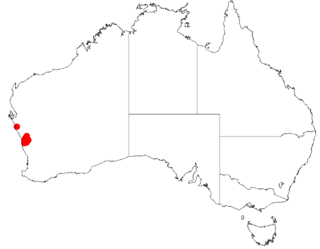
Pityrodia viscida is a flowering plant in the mint family Lamiaceae and is endemic to the south-west of Western Australia. It is an erect shrub with sticky hairy stems, egg-shaped to narrowly elliptic leaves and white bell-like flowers.
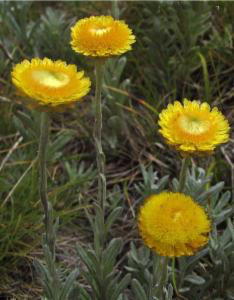
Coronidium monticola, commonly known as the mountain coronidium, is a flowering plant in the family Asteraceae and grows in open forests in eastern Australia. It has woolly, grey-green leaves and mostly yellow flowers.

Frankenia cordata is a flowering plant in the family Frankeniaceae and grows in Western Australia, South Australia and the Northern Territory. It is a small, spreading shrub with pink flowers.

Leucopogon thymifolius, commonly known as thyme beard-heath, is a species of flowering plant in the heath family Ericaceae and is endemic to Victoria. It is a slender shrub with spreading, egg-shaped to oblong leaves and white to pale pink, tube-shaped flowers arranged in spikes of seven to thirteen in leaf axils, or on the ends of leafless branches.
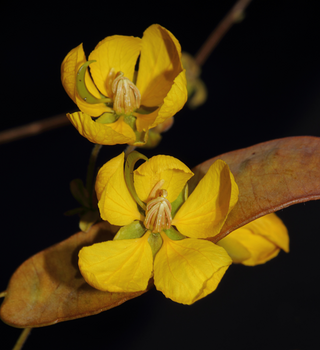
Senna pilocarina is a species of flowering plant in the family Fabaceae and is endemic to inland Western Australia. It is a prostrate or upright, spreading shrub with pinnate leaves with five to nine pairs of oblong to wedge-shaped leaflets, and yellow flowers arranged in groups of four or five, with ten fertile stamens in each flower.
















